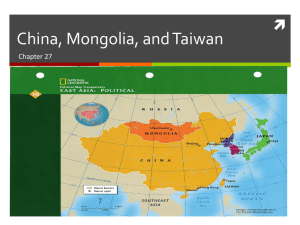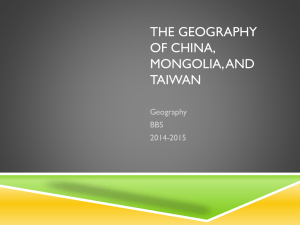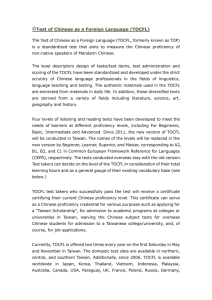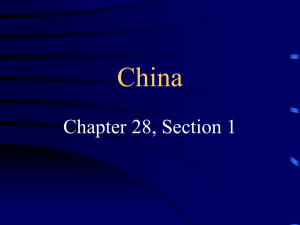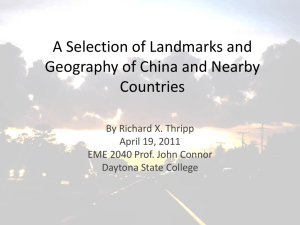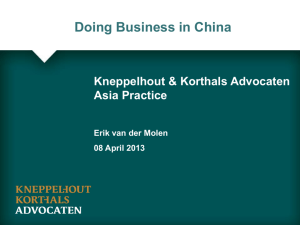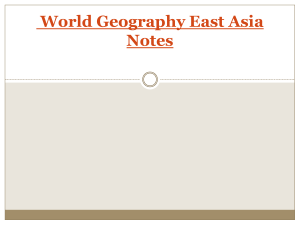Chapter Five
advertisement
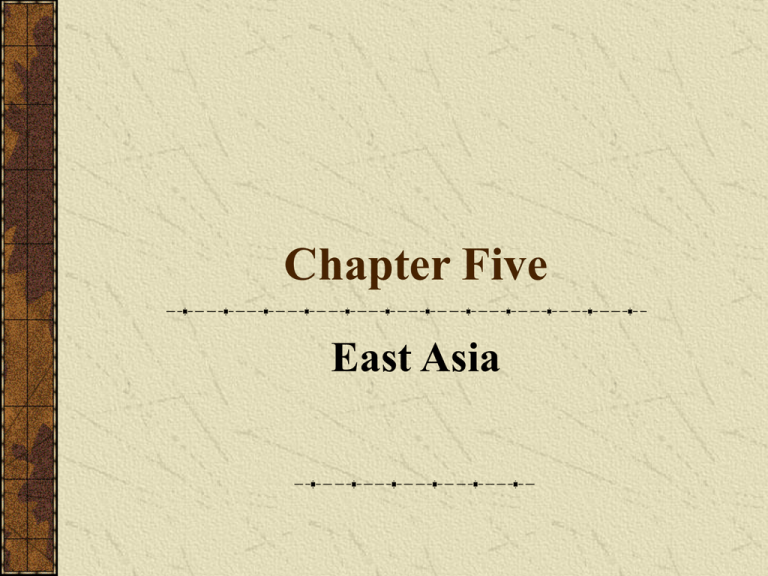
Chapter Five East Asia East Asian Miracle Reemergence as a world political, economic, and cultural force Technological development since ancient times Ancient cultures East Asian Miracle (cont’d) From Poverty and Defeat to Renewed Eminence Japan defeated in World War II Korea divided north and south China governed by Communists after defeating nationalists East Asian Miracle (cont’d) Will Miracle Growth Continue? Uneven development 1997-1998 economic crisis revealed weakness in the economic practices of the “Asian Way” Cultural and Political Influences Chinese Empires Foundations of Chinese Cultures • Confucius (Kong Fuzi) • Daoism (Laozi) Mongol Invasions Later Empires Cultural and Political Influences (cont’d) Japanese Isolationism Shinto Korean Origins Responses to European Intrusions China Resists Colonization Disrupted Chinese Republic Japan Asserts Its Independence Natural Environments Subtropical and Midlatitude Climates Monsoon climatic environment Midlatitude east coast climatic environments Mountains and Major Rivers Himalayan Mountains (Mt. Everest) Tibetan Plateau Huang He (Yellow River) Chang Jiang (Yangtze or Long River) Xi Jiang (West River) Zhu Jiang (Pearl River) Natural Environments (cont’d) Forests, Grasslands, and Desert Natural Resources Surface water flows Fertile soils Minerals • Coal • Oil • Natural gas Natural Environments (cont’d) Country Boundaries Environmental Problems Natural Hazards Human Impacts and Responses Diseases Pollution Environmental Policies Globalization and East Asia Most countries cluster toward the top of the world range of gross national income. China and Japan lead in the next phases of globalization. Trade with the United States and Europe is important. Increasing trade with Southeast Asia. Globalization and East Asia (cont’d) Global City-Regions In the Forefront: Japan, South Korea, and Taiwan Japan Multinationals International Tourism Recent Entry: China China and Global Culture Subregions Japan The Koreas, North and South China—including Hong Kong (Xianggang) since 1997 and Macau since 1999, Taiwan, and Mongolia Subregions (cont’d) Population Distribution Highest population densities along the eastern and southern parts of Japan, the western parts of the Koreas and Taiwan, the north-central part of China, and the coasts and major river valleys of southern China. Lowest population densities in the western half of China and Mongolia. Japan People Ethnicity Rural to Urban Populations • Megalopolis • Suburbanization • Counterurbanization Population Change • Low fertility and population growth rates • Aging population Japan (cont’d) Economic Development Postwar Changes Agriculture Manufactures: Beginnings of Modernization Manufactures: Reconstruction • Ministry of International Trade and Industry (MITI) Manufactures: Challenges and Changes Service Industries Japan (cont’d) Japan’s Regions and Cities Hokkaido Honshu Shikoku Kyushu Ryuku Islands Japanese City Landscapes The Koreas Countries North Korea: Communist South Korea: Paternalistic dictatorships to democracies supported by the United States People Urban Focus The Koreas (cont’d) South Korean Economic Development Fast economic growth Iron and steel, shipbuilding, chemicals, automaking, textiles, and now high-tech Chaebol Economic Stagnation in North Korea Isolationist Economic decline and famine China, Mongolia, and Taiwan China China’s Ups and Downs Under Communism Collectivization and Communes The Great Leap Forward and Cultural Revolution China Joins the Wider World • Household responsibility system Tensions in the 2000s China and the World Trade Organizaton China, Mongolia, and Taiwan (cont’d) People in China Ethnicity • Han Chinese Urban Versus Rural Population in China Chinese Population Dynamics Attacking Poverty in China Overseas Chinese • Transnational Chinese economy Point-Counterpoint: (cont’d) POINT The one-child policy results in fewer births that place claims on national resources. It brings slower population increase and a more balanced population structure in the early stages. COUNTERPOINT Family planning is most successful when parents act on their own initiative, perhaps guided by information. It upsets the population balance between sexes (abortion and murder of baby girls) and age groups (in the later stages when there are small numbers of young people and increasing numbers of older people). Point-Counterpoint: (cont’d) POINT It allows better planning for urban expansion, housing, education, job availability, and transport and utility infrastructure. COUNTERPOINT It ignores other factors in population growth, including migration, the effect of natural disasters (as during the Great Leap Forward) and diseases, and the impact of political chaos (as in the Cultural Revolution). Point-Counterpoint: (cont’d) POINT It provides control by the government and local officials in the interests of the whole population. It brings a rapid realization of the importance of family planning in the face of imminent overpopulation disaster. Other policies had failed. COUNTERPOINT It often requires draconian methods of control that go against human rights. It ignores cultural and economic factors that favor large families. China, Mongolia, and Taiwan (cont’d) Economic Development The Chinese Economy, 1949-1976 New Policies and New Growth After 1976 Farming in the 2000s Water Resources Chinese Energy Policy Growth in Chinese Manufacturing Increasing Steel Output China, Mongolia, and Taiwan (cont’d) Regions and Cities in China Coastal Regions Interior Behind the Coastal Regions Deep Interior Regions Chinese Regional Development Policies • Special economic zones Hong Kong • Entrepôt Macau’s New Approach to Gaming Chinese City Landscape China, Mongolia, and Taiwan (cont’d) Mongolian Isolation Mongolian People Mongolia’s Limited Resources Taiwan Taiwanese People Taiwanese Economy
